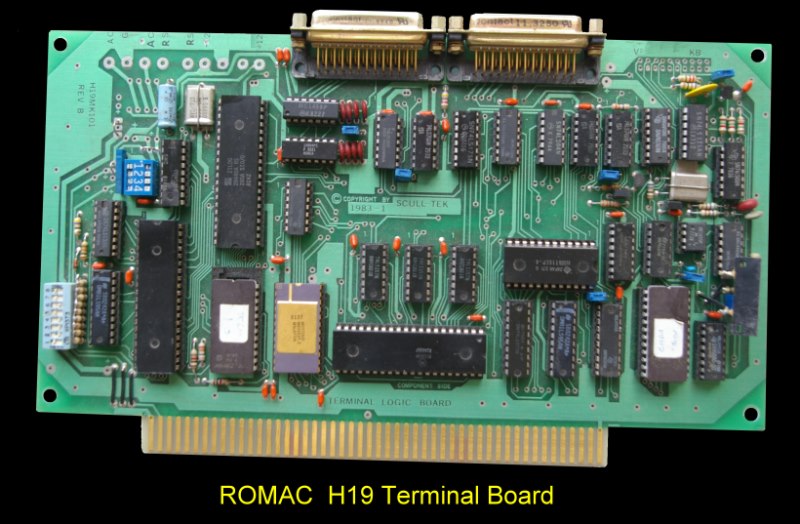This is perhaps one of the most unusual S-100 boards in the collection.
The board utilized only the power lines from the S-100 bus. No other pins
were connected to the board. In fact the board was often used outside the
bus by simply connecting the required power lines to the solder points on
the top left hand section of the board. It used less than 1 Amp on the +5
Volts line.
The ROMAC H19MK101 terminal provided the versatility needed for a truly
efficient computer interface through its many built in features. These
features included such things as Cursor Control/Reverse Video, simple
graphics, Report Cursor Position, Downloadable Keyboard Handler Routines,
Editing Functions and much more! It also provided a keyboard interface which
could support special function keys and detachable keyboards easily.
For compatibility with available software, the ROMAC Terminal used the same
command format as two popular terminals of the time; the Heath H-19 (or
Zenith Z-19) and the Digital Equipment Corporation VT-52. This meant that
any program written to use the special functions of either of these
terminals
would be
totally
compatible
with
the
ROMAC
Terminal.
This section will provide a brief circuit description of each
of the major integrated circuit components of the ROMAC H19MK10l Terminal.
Z80 CPU
The Z80A is a 4MHZ version of the Z80 processor and was used to handle all
IO control to and from the board. It had its own EPROM and used the 2K of
the 4K of on-board RAM
Z80 DART or SIO/O Serial I/O Devices
These Z80 serial communication devices contain two serial I/O ports and
their associated control logic. All common asynchronous serial protocols are
supported. The SIO also supports many common bit or byte oriented
synchronous protocols. Each channel of these devices has an 8 bit register
for data to be transmitted and three registers in a FIFO arrangement for
received data. In addition, each channel has eight control registers (ten
for the SIO). These registers are accessed by first writing a byte which
indicates which register is to be used. Register 2 of port B was used for
the interrupt vector.
6845 CRT Controller
The 6845 is a device which coordinates all the functions necessary to
control a CRT monitor device. Though video data doesn't actually pass
through the device, it handles data transfer control, cursor positioning,
and screen formatting tasks. It is in control of the display memory and
character generation memory which provide the data to be displayed on the
screen. Although the 6845 is a complex device, it provides no internal
logic for handling memory access arbitration or cursor generations external
logic. These functions have to be provided by t
he CRT
Controller which has 19 internal registers which must be programmed with the
operating parameters before the device can function. These parameters
determine the timing characteristics of the CRT interface. The number of
lines, number of characters per line, and location of the top of the page
are derived from these characteristics.
The board had 2 K of static RAM for operations, 2K of display RAM, and 4 or
8K of EPROM. The keyboard input could be RS-232 or TTL serial. Output
was either composite video or separate H & V sync. The display was
24X80 with a 25th line as an option.
The manual for this board can be obtained
here.

